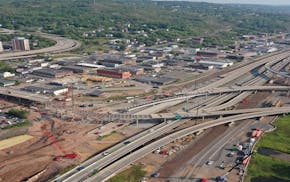Metro Transit will switch from running three-car trains to two on its Blue and Green lines starting Saturday. The move comes as the agency seeks to reduce stress on a short-handed maintenance staff and wear-and-tear on its vehicles.
But that should not lead to overcrowding, Metro Transit Chief Operating Officer Brian Funk told the Met Council Transportation Committee Monday.
"You see there is quite a lot of extra space," Funk said.
By running shorter trains, the agency expects to save $500,000 on parts and labor and 1 million miles a year, he said.
"We have unnecessary mileage accumulation and the cars need to be inspected more than they should," Funk said. "We are not at an ideal staffing point on the maintenance side."
The agency will continue to use three-car trains on weekdays until mid-June when the University of Minnesota begins its summer schedule and demand drops. Then it will use two-car trains all hours of the day, every day, with longer trains on event days, the agency said.
Metro Transit's use of three-car trains on high-demand days takes into consideration events such as Twins and Loons games and stadium concerts.
Ridership on the Green Line, which runs between downtown Minneapolis and St. Paul, is down 21% from pre-pandemic levels. Riders have taken 1.5 million trips during the first two months of the year, a 28% increase over 2023, Metro Transit said.
The Blue Line, which runs from downtown Minneapolis to the Mall of America in Bloomington, has provided 966,000 rides during the first two months of the year. That is about the same as in 2023 but still a third lower than before the pandemic, figures show.
Trains on both lines will continue to run at about 15-minute intervals. By August, the agency hopes to increase frequency to 12 minutes with a long-term goal of operating every 10 minutes.
To prepare riders for the change, audio and video announcements will play on light-rail platforms and new signage will go up this week. Metro Transit also will be asking riders to provide feedback.
Walz selects leader for new state agency focused on children and families

Parts of Twin Ports Interchange project could open in fall; completion is in sight
Man sentenced to 16 years for fatal sucker punch on St. Paul light rail platform

